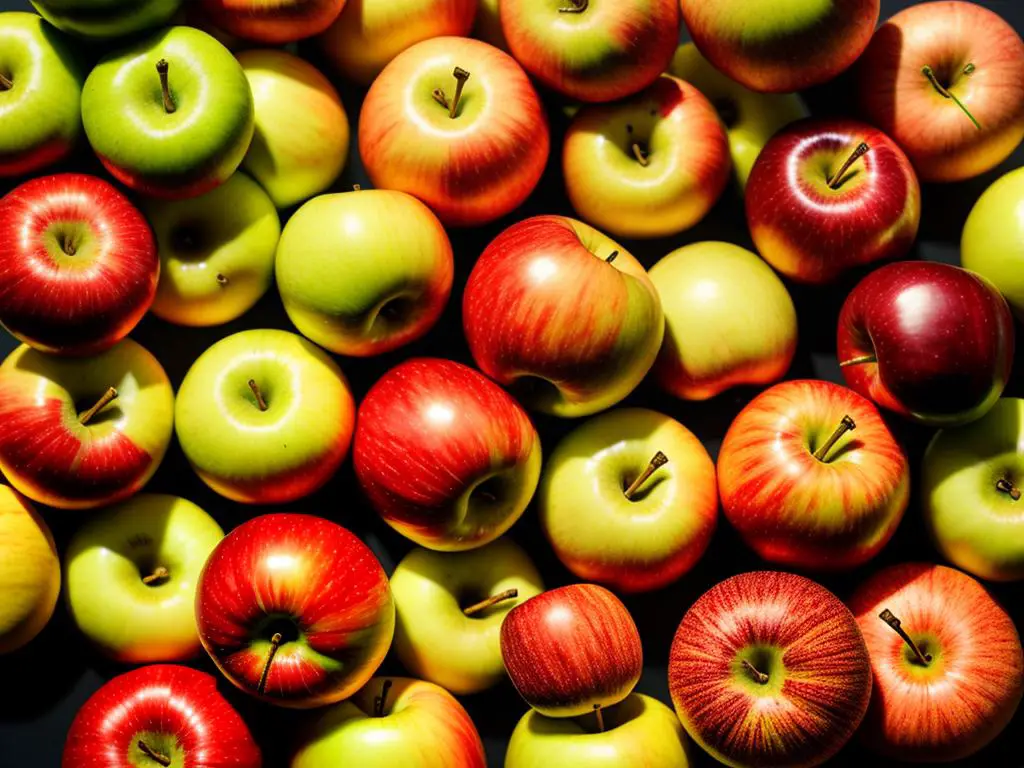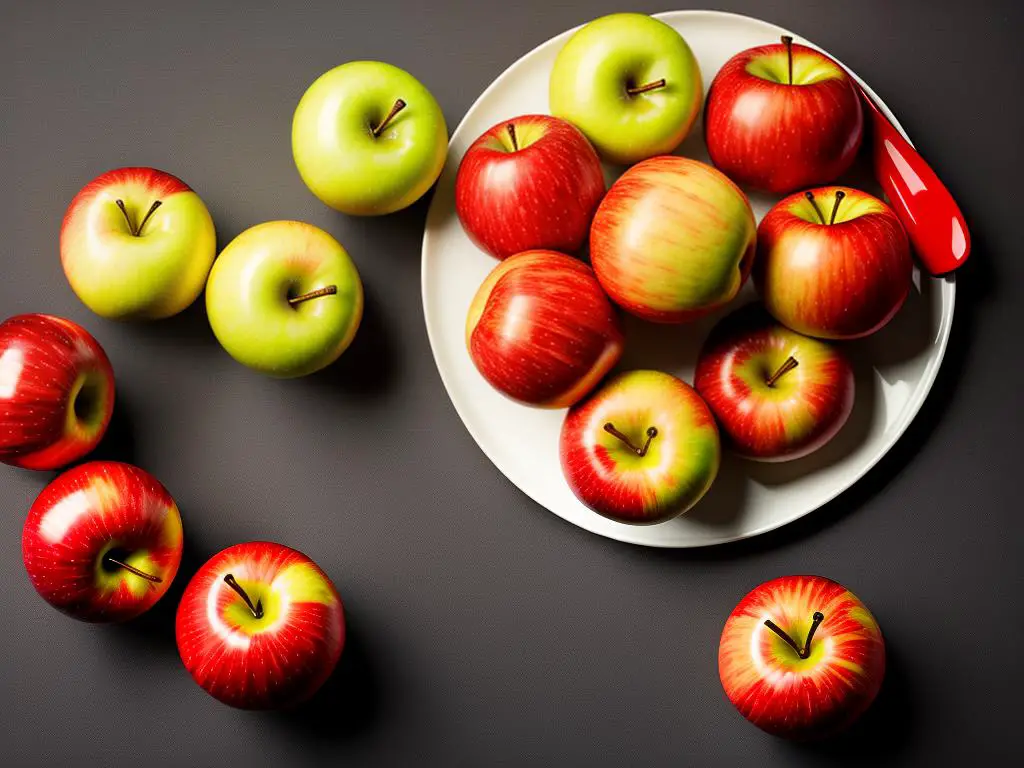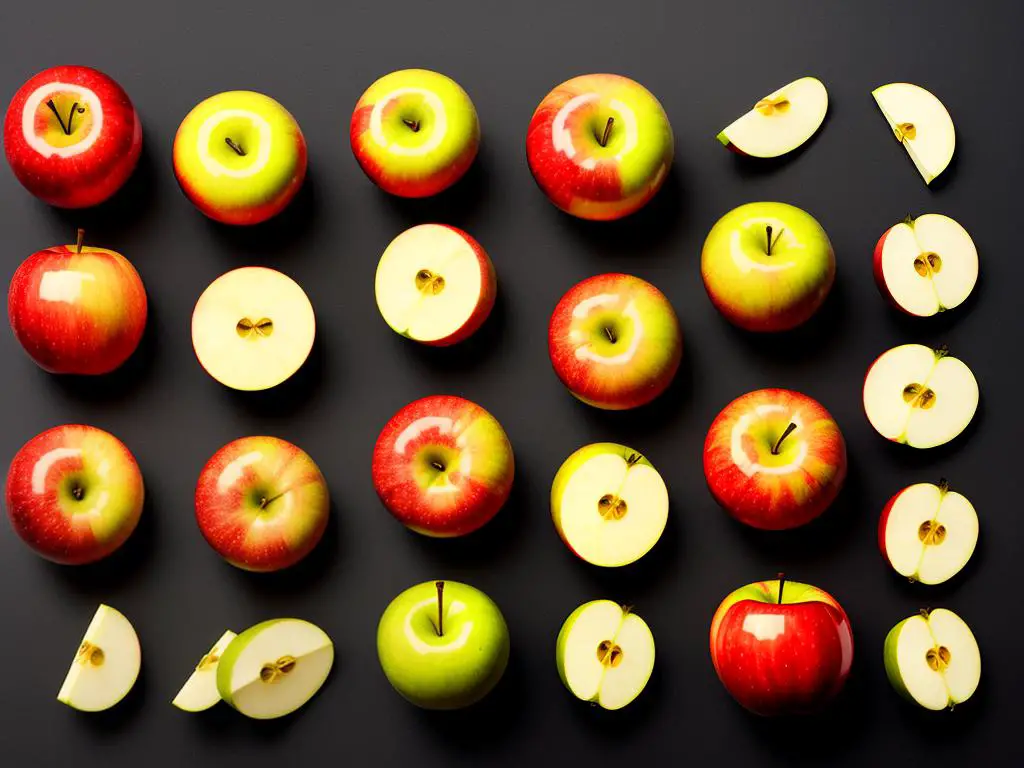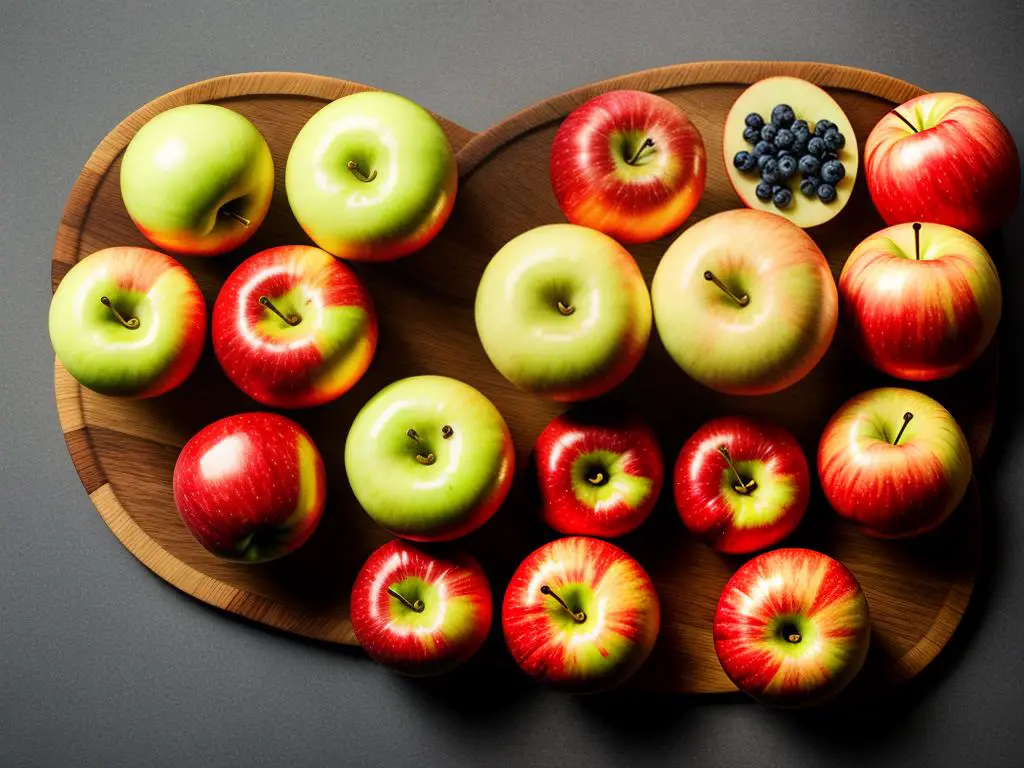Apples, possibly the most iconic of fruits, carry a range of taste profiles and uses that exceed the simple “apple a day” adage. Known for their versatility, apples come in countless varieties, each with its unique flavor and texture signature. From tart Granny Smiths to the indulgently sweet Fujis, understanding their unique traits allows us to fully appreciate and utilize this beloved fruit. This exploration begins with the intriguing initiative called the apple taste chart. This comprehensive guide breaks down apple varieties not merely by sweetness or tartness but delves deeply into nuances, including crunchiness, color, texture, and even how each variety’s taste unfurls throughout the seasons and cooking processes.
Understanding The Apple Taste Chart
Understanding the Apple Taste Chart
Understanding the Apple Taste Chart is a method used to differentiate apple varieties based on specific taste and texture parameters. The apple taste chart is essential for identifying apple varieties suited to various culinary uses or specific personal flavor preferences.
The Three Main Characteristics
The chart functions by classifying apples based on three main characteristics: sweetness, tartness, and crunchiness. Sweetness refers to the sugary flavor of the apple. Tartness is the sour or sharp flavor that gives apples their unique kick, while crunchiness relates to the firmness and crispness of the apple when bitten.
Rating Scale
Sweetness is generally rated on a scale of 0-9, with 0 being not sweet at all and 9 being extremely sweet. Tartness is also measured on a scale of 0-9, whereas crunchiness is typically rated from soft to very hard.
Sweetest Apple Varieties
Amongst the sweetest apple varieties, you’ll commonly find Fuji, Golden Delicious, and Gala apples. These are often associated with a sweetness rating of 7-9. Their sweetness makes them ideal for use in desserts or for eating raw.
Tart Apple Varieties
In contrast, Granny Smith and Braeburn are known for their tartness, with ratings typically sitting around 7-9 on the tartness scale. Such varieties are frequently used in dishes requiring a bit of acidity for balance, such as apple pies or ciders.
Crunchy Apple Varieties
Conversely, McIntosh and Red Delicious sit on the opposite end of the crunchiness scale. McIntosh is known for its soft, easily breakable flesh, while Red Delicious is renowned for its extremely crispy texture.
A Balance of Sweetness, Tartness, and Crunchiness
Certain apple types like Honeycrisp and Pink Lady strike a balance between sweetness and tartness, providing a harmonious taste that many enjoy. These apples also boast a satisfying crunch, making them a favorite among apple connoisseurs for their well-rounded flavor profile.
Factors Affecting the Chart Parameters
Moreover, it should be noted that the parameters on the apple taste chart can be influenced by factors such as apple maturity and storage conditions. An apple’s sweetness can intensify as it matures, while prolonged storage can affect its crunchiness.
The Value of Understanding Apple Flavors
Acquainting oneself with the apple taste chart is not only beneficial for apple growers and retailers but can equally be of immense value to consumers. Learning about different apple varieties enhances the overall apple consuming experience, whether you use them for baking, cooking, or simply enjoy them as a fresh snack. Familiarizing yourself with the apple taste chart can guide you towards a more flavorful, satisfying apple choice.

Exploring Different Apple Varieties
An In-depth Look at Fuji Apples
Originating from Japan, Fuji apples command attention with their sweet flavor profile, enhanced with subtle hints of honey and citrus. Their distinctive look comprises a reddish-pink blush over a yellow-green base and is a result of cross-breeding two American apple varieties, Red Delicious and Virginia Ralls Genet. Particularly known for their firm, crisp, and juicy texture, the Fuji apples have made a name for themselves in the realms of snacking, tossing in salads or pairing with cheese. They also particularly shine in baking scenarios due to their ability to retain their structure and flavor during cooking.
Granny Smith Apples
The bright green Granny Smith apples, originating from Australia, are renowned for their tart taste. With their distinctively crisp and firm flesh, they are ideal for baking in pies and tarts, as they hold their shape well even after cooking. The sourness moderates and sweetens with heat, making for a perfect balance when used in desserts. Granny Smith apples are also enjoyed raw, thereby making a healthy, flavorful snack packed with antioxidants and dietary fiber.
Honeycrisp Apples
Developed in the University of Minnesota, Honeycrisp apples are well-loved for their remarkably crisp and juicy texture. They provide an interesting balance of sweetness and tartness, which makes them perfect for eating fresh. Recognizable by their speckled red exterior over a pale background, honeycrisp apples are vastly appealing. The crispness and the fact that they don’t brown easily makes them a desirable choice in salads and other fresh preparations. Moreover, their balanced sweetness makes them suitable for baking as well.
Gala Apples
Originating from New Zealand, Gala apples have a distinctive, crisp texture and sweet, snappy taste. Clad in a beautiful mix of bright orange-red and yellow colors, they are a favorite for both children and adults. Due to their firm texture and natural sweetness, they are optimally suited for snacks and fruit salads. Gala apples also perform well in pies, muffins, and sauces, although they might not hold up their shape as well as the tart Granny Smiths when subjected to heat.
Red Delicious Apples
Originating from America, Red Delicious apples are well-known for their distinctly dark red color and slightly elongated shape. These apples have a firm texture and a mild sweetness that makes them highly enjoyable when eaten fresh. However, their flavor tends to diminish and the texture becomes mealy when cooked – a reason why they are primarily savored fresh. Red Delicious apples are a popular choice for eating raw, juicing, or adding to salads. Moreover, they also offer several health benefits including dietary fiber and essential antioxidants.

Seasonality and Apple Taste
An Exploration of Flavor: Decoding the Seasons of Apple Taste
Factors such as the season, the apple variety, and how they are grown contribute to the varying taste of apples. With a plethora of apple variants to choose from, you can experience an array of flavor combinations which can be sweet, tart, crunchy, mushy, juicy, or even dry.
The season when the apples are harvested significantly influences their taste. For instance, apples reaped in the tail end of summer or early in the season, usually possess a fresh, tangy flavor due to their higher acidity and lower sugar content. Their sweetness hasn’t fully developed yet since they are not ripe enough.
On the other hand, apples harvested at the peak of fall or during mid-season typically exhibit a balanced flavor. This is characterized by the perfect blend of sweetness and tartness as seen in Honeycrisp and Gala apples, which are harvested around this time, offering a crunchy bite and a sweet-tart taste.
Lastly, apples harvested towards the end of fall, referred to as late-season apples, exude natural sweetness and intricate flavors. They boast a deep, robust flavor profile due to their high sugar content, kitting them out ideally for baking and dessert preparation. The Granny Smith and Braeburn varieties epitomize late-season apples showcasing their crisp, tart, and discreetly sweet flavors.
Apple Varieties and Their Taste Profiles
To truly savor apples, understanding their seasonality is crucial. Certain apple varieties, such as McIntosh apples, are incredibly flavorful when harvested fresh in September. In contrast, Rome apples deliver their best taste after storing over some time, reaching their flavor peak in January.
Several chemical changes occur as apples ripen, leading to taste variations throughout the seasons. These changes include reduced acidity, increased juiciness, color shifts from green to red or yellow, and a softer texture. Above all, apples develop an enhanced sugar content as they ripe, transforming into a sweeter fruit.
Climate is another aspect impacting apple taste and quality. Apples cultivated in colder temperatures are likely more crisp and tart, whereas those from warmer climates are often softer and sweeter. This variation stems from how different temperatures influence the ripening process – while cooler weather slows down maturation preserving tartness, warmer climates fast-track it, resulting in sweeter apples.
It’s essential to note that each apple variety bears unique characteristics in terms of taste, texture, and color. These characteristics can be affected by the growing season and climate. Thus, while a helpful tool, the apple taste chart should be approached as a guideline given individual tastes differ.

Best Uses of Each Apple Variety Based on Tastes
Decoding the Flavor Spectrum of Apples
With over 7,500 apple varieties across the globe, each offers a unique flavor journey. To differentiate these various types, an apple taste chart proves significantly helpful, as it breaks down these fruits based on their sweetness, tartness, and juiciness. Having this understanding of unique flavor profiles makes it easier to select the ideal apple type for specific culinary endeavors.
Sweet Apples: Best for Baking
Sweet apples such as Fuji, Honeycrisp, and Golden Delicious are often preferred for baking purposes. They contain high sugar content that caramelizes during the baking process, giving the recipes a deeper flavor. Fuji apples are crisp, super sweet, and are known for their honeyed taste, making them a favorite for apple pies. Honeycrisp is also extraordinarily sweet but possesses a slight tartness that contrasts well with the sweetness, offering a balance of flavor. Golden Delicious, as the name suggests, has a rich, honeyed sweetness that makes them excellent for baking muffins or bread.
Tart Apples: Great for Salads
When it comes to salads, apple types with a tart characteristic like Granny Smith and Braeburn suit best. Granny Smith apples are renowned for their vibrant green skin and tart, tangy flavor that provides a fresh contrast to other salad ingredients. Braeburn apples are classically tart with a subtly sweet undertone, making them a flavorful and crunchy addition to any salad.
Juicy Apples: Perfect for Juicing
For juicing purposes, apple varieties that are both sweet-tart and juicy, such as McIntosh or Pink Lady, work wonderfully. McIntosh apples are tangy and somewhat floral, providing a zesty bite and ample juice that makes them a favorite for apple juice. On the other hand, Pink Lady apples – also known as Cripps Pink – are quite crisp and extraordinarily juicy. They have a unique sweet-tart taste, with a subtle fizz that’s quite refreshing, providing an exciting flavor to your juice.
Balanced Apples: Ideal for Snacking
Apple types with a balanced taste, generally sweet with a hint of tartness, are great for snacking. Gala apples or Red Delicious are perfect examples. Gala apples are crisp, sweet, and very slightly tart, making it a refreshing and satisfying snack. Red Delicious, despite its sweet moniker, has a combination of sweetness and mild tartness. With their crunchy texture, they have been a universal snacking choice.
An apple taste chart is an invaluable tool for consumers, providing anticipatory details about the different apple varieties they may select for various culinary endeavors like baking, preparing salads, juicing, or even just for snacking. Each kind of apple possesses distinctive flavor traits which, when applied to the right culinary context, promise to deliver delectable results every time.

Cooking and the Effect on Apple Taste
It’s important to bear in mind how cooking methods can vastly affect the taste and texture of these diverse apple varieties.
You’ll find that each apple type has a characteristic taste chart that signals varying levels of sweetness, tartness, astringency, and umami. These flavors can either be amplified or subdued, according to the manner in which they’re cooked.
For example, the Granny Smith apple, renowned for its tart and somewhat sour taste, mellows down when cooked.
This transformation stems from the heat, which breaks down the malic acid that gives the apple its tartness. When heated, the apple becomes softer and sweeter. This outcome lends itself perfectly to a variety of dishes, from pies to sauces.
Honeycrisp apples’ taste is remarkably altered when cooked.
Known for its crisp and sweet juice raw, its sugar intensifies under heat, creating an even sweeter palate. Its firm texture, however, may turn mushy under intensive heat. Therefore, it would be best to use such apples for baking or making sauces where their texture won’t be an issue.
Red Delicious apples withstand heat exceptionally well.
When cooked, its oft-criticized mealy texture transforms into a tender delight, seamlessly integrating into any dish. As the heat releases more sugars, the flavor of the Red Delicious is also transformed from somewhat bland when raw to pleasantly sweet when cooked.
On the other hand, Gala apples, which are delicately sweet and mildly tart when eaten raw, retain their sweet flavor even after being cooked.
But, their texture softens significantly when heat is applied, making them more suitable for applesauce or apple butter.
Golden Delicious apples, with their naturally sweet, mild flavor, become even sweeter when cooked.
They maintain a balanced blend of sweetness and tanginess; however, a slight softening in texture occurs when cooked, making them excellent for baking, frying, roasting, or even grilling.
Jonagold apples, a hybrid between Jonathan and Golden Delicious, boast a complex flavor profile with a balance of sweetness and tartness.
When cooked, their sweetness intensifies, and they soften nicely, making them particularly beneficial in pies or tarts.
The temperature, duration, and method of cooking play a huge role in determining how the flavors of the apples are altered.
Baking, roasting or grilling generally intensifies the natural flavors of the apples, while boiling in water would mute them down. It is also essential to recognize that certain underlying flavors may become more pronounced as the apple’s structure breaks down with cooking.
Knowing how cooking impacts different apple varieties is helpful in pairing them with the right cooking methods.
This, in turn, has the potential for creating delicious dishes that both showcase and complement the apples’ unique flavors. Knowing your apples and their taste charts is just the first step; understanding how to use them is the ultimate tribute to the fruit.

The humble apple holds an impressive character that changes with each variety, season, and even method of preparation. Realizing the intricate relationship between these factors and the subsequent transformation of flavors provides an enriching appreciation of this world-favored fruit. Whether you’re reaching for an apple as a healthy snack, creating a refreshing salad, or experimenting with a heartwarming pie, let the apple taste chart guide your decisions. Let the diverse world of apple qualities inspire you, elevate your culinary creations, and most importantly, satiate your palate in a way it never has before.

